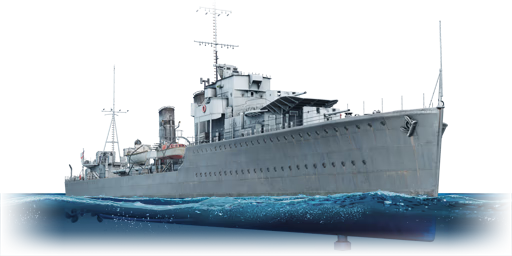



The HMS Grafton (H89) is a member of the G-class destroyer family. She was constructed in the mid-1930s, when the HMS Grafton was stationed in Spanish waters from 1936 to 1939 to enforce the non-interventionist agreements reached by Britain and France during the Spanish Civil War. She was transferred from the Mediterranean Fleet to the UK for escort and contraband inspection duties after World War II began. When the Norwegian Campaign started in April 1940, the HMS Grafton was undergoing refit; after the work was finished, the HMS Grafton escorted convoys to Norway. In May, she rescued British troops from the bridgehead of Dunkirk; however, a German submarine sank her after she stopped to recover survivors from a destroyer.
Introduced in Update 1.83 "Masters of the Sea", the HMS Grafton is equipped with heavy firepower for her size. However, she remains extremely vulnerable to most enemy destroyers. The HMS Grafton is most useful when employed as a quick-light support destroyer, evading enemy fire with its superior mobility. The HMS Grafton may be able to survive confrontation with other enemy destroyers thanks to her powerful main armament, but she will almost definitely come out of it severely damaged. Therefore, the best chances are to move or hide deep behind the enemy, attack first, and maintain the distance.
| Ammunition | Type | Armor penetration (mm) at a distance: | |||||
|---|---|---|---|---|---|---|---|
| 1000 m | 2500 m | 5000 m | 7500 m | 10000 m | 15000 m | ||
| HE | 35 | 35 | 35 | 35 | 35 | 35 | |
| SAP | 127 | 98 | 64 | 43 | 31 | 27 | |
| HE-TF | 35 | 35 | 35 | 35 | 35 | 35 | |
| HE-VT | 35 | 35 | 35 | 35 | 35 | 35 | |
| Belt | Belt filling | Armor penetration (mm) at a distance: | |||||
|---|---|---|---|---|---|---|---|
| 10 m | 100 m | 500 m | 1000 m | 1500 m | 2000 m | ||
| T/AP/HEI | 24 | 24 | 21 | 18 | 16 | 15 | |
| T/HEI/HEI/HEI | 20 | 19 | 16 | 14 | 12 | 11 | |
| T/AP/HEI/AP | 24 | 24 | 21 | 18 | 16 | 15 | |
2 × Y-gun Mk.VII depth charge











Seakeeping |
|---|
Unsinkability | |
|---|---|
Firepower | ||
|---|---|---|